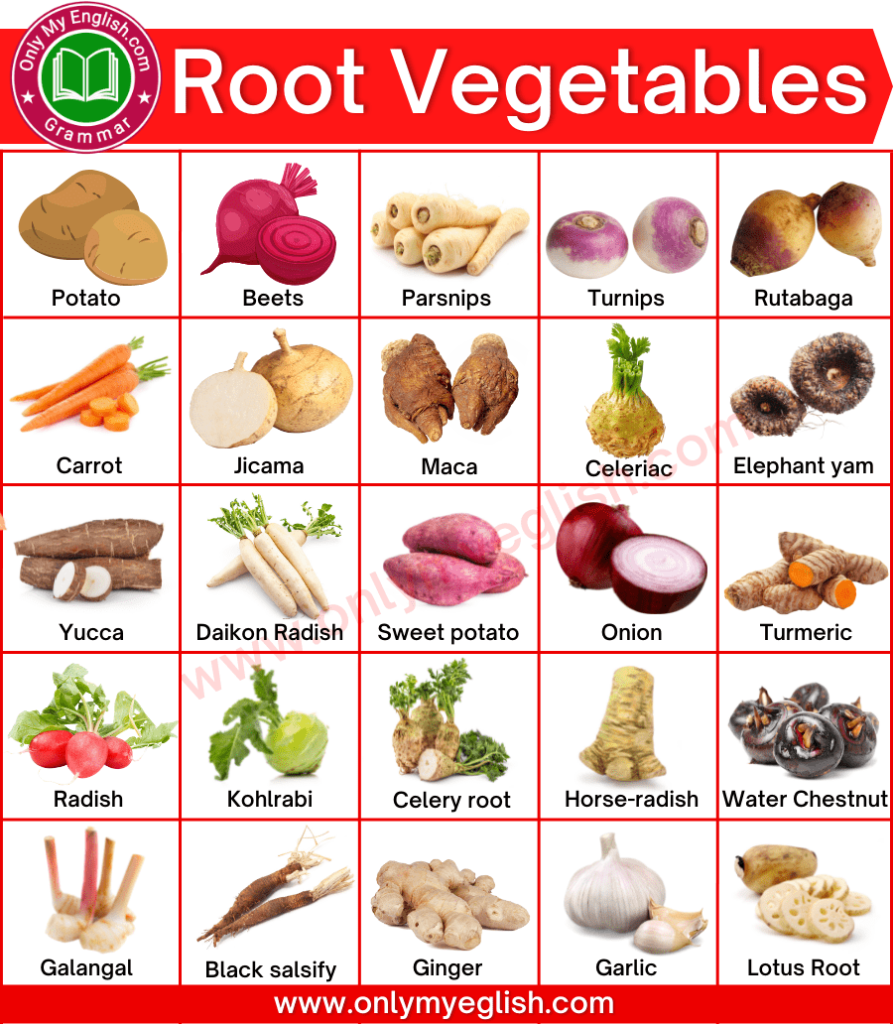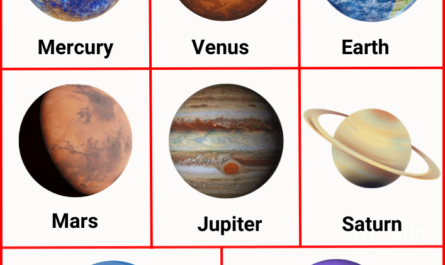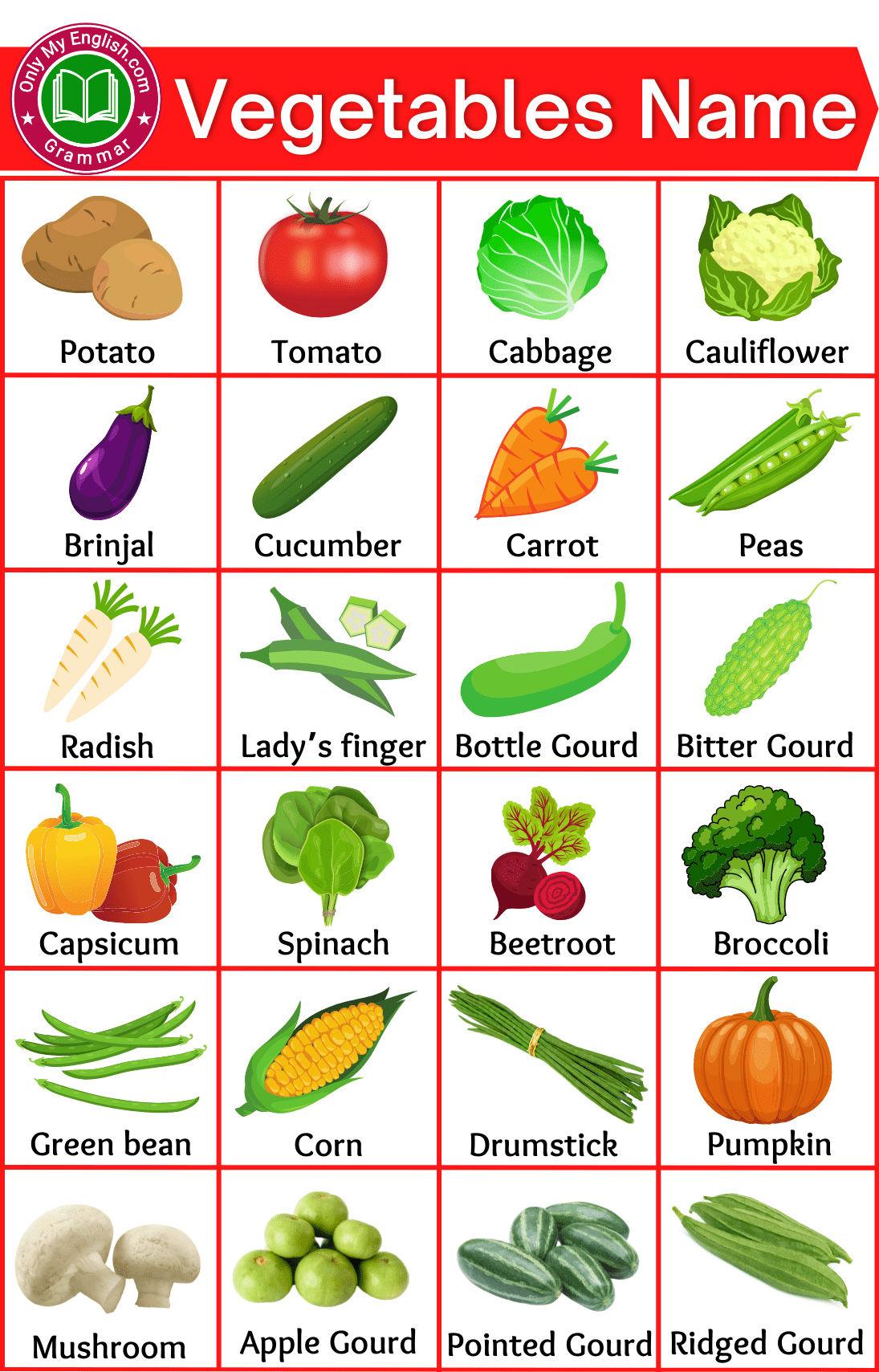In this post, We have covered most of the essential and common root vegetables that are consumed and produced by humans, and also their details are also given below.
Root Vegetables
The root vegetables are those edible plant parts that are fleshy and grow underwater full of starch and essential nutrients. These root vegetables are very good for health, and the root organs of the plants are the energy-rich part that stores starch and other essential nutrients and minerals like carbohydrates, proteins, and vitamins. It is mostly liked and consumed by humans.
Many root vegetables are eaten and enjoyed as a delicious part of a healthy and suitable diet for a long time. It is interesting to note that they have been enjoyed by the rich and noble from the beginning of time.

List of Root Vegetables with their Scientific Names
- Potato (Solanum tuberosum)
- Radish (Raphanus sativus)
- Sweet potato (Ipomoea batatas)
- Onion (Allium cepa)
- Beetroot (Beta vulgaris)
- Carrot (Daucus carota)
- Turmeric (Curcuma longa)
- Garlic (Allium sativum)
- Ginger (Zingiber officinale)
- Kohlrabi (Brassica oleracea)
- Lotus Root (Nelumbo nucifera)
- Jerusalem Artichoke (Helianthus tuberosus)
- Japanese Artichoke (Stachys sieboldii)
- Celery root (Apium graveolens var. rapaceum)
- Turnip (Brassica rapa)
- Horse-radish (Armoracia rusticana)
- Yucca (Yucca)
- Water Chestnut (Eleocharis dulcis)
- Burdock root (Arctium lappa)
- Cassava (Manihot esculenta)
- Daikon Radish (Raphanus sativus var. longipinnatus)
- Jicama (Pachyrhizus erosus)
- Galangal (Alpinia galanga)
- Maca (Lepidium meyenii)
- Shallot (Allium ascalonicum)
- Black salsify (Scorzonera hispanica)
- Rutabaga (Brassica napobrassica)
Root Vegetables with their Details
Potatoes (Solanum tuberosum)
Potatoes are nutrient-rich root vegetables. It is a very common vegetable for humans for their daily diet. It is rich in starch, carbohydrates, proteins, minerals, and various vitamins. There are multiple ways to eat potatoes by boiling, frying, making dishes, chips, and other means also helps to reduce the risk of many lifestyle-related health conditions.
Radish (Raphanus sativus)
Radish is an edible, small root nutritional vegetable mostly used to make dishes, salads, and other crunchy meals or snacks. It can be eaten raw as salads having a pungent smell and grown throughout the world. It is rich in vitamins and minerals that are good for the human body.
Sweet potatoes (Ipomoea batatas)
The sweet potato belongs to the family Convolvulaceae. It is rich in starch tuberous root vegetables with a sweet-tasting. These are the powerhouse of antioxidants and an excellent source of beta-carotene, which is very effective against many diseases and improves the immunity level and skin health. It can be consumed by boiled, raw, baked, roasted, or other means.
Onion (Allium cepa)
Onions are a very good antioxidant food that helps to reduce the risk of cancers and blood sugar levels of the body. It is a very efficient root vegetable mostly added to various dishes and cuisines. The onion can be consumed raw by adding it to salads, cooked with different dishes, soups, scrambled eggs, or many recipes that give a good texture to the food.
Beetroot (Beta vulgaris)
Beetroots are one of the most nutritious root vegetables with plenty of fiber, manganese, and folate. It is beneficial in increasing blood flow to the brain by decreasing blood pressure and improving heart health. These root foods are easily consumed by roasting, making juice, boiling, or serving with salads.
Carrot (Daucus carota)
The carrots are one of the most well-known, delicious, very effective, nutritious root vegetables.
It has plenty of antioxidants and beta carotene, which helps to control the cholesterol level and also control the diabetes of the body. It is also good in lowering the risks of cancer of the chest, blood, breasts, etc. It can be consumed as salads, snacks, eaten raw or dipped, or making a sweet dish with milk and butter in India.
Turmeric (Curcuma longa)
Turmeric is a type of root vegetable belonging to the family of ginger cardamom. The rhizomes or roots of this plant are mostly served as a spice that adds color and flavor to various cooking dishes. It is also good for absorbing the pain from the joints and healing wounds very fast. It is also good in stabilizing the blood sugar level and depression. It is popular in serving with milk to cure any fevers and diseases.
Ginger (Zingiber officinale)
Ginger is a flowering plant, and its root is a fleshy portion called ginger-like turmeric, which is used in cooking food as a spice to add some delicious flavors. It is very popular to add tea while making it. It is filled with antioxidants, and a unique compound called Gingerol, effectively decreasing pain and inflammation. And also provide relief in menstrual pain and some osteoarthritis. It is also good for pregnant women that helps them from morning sickness and reduces nausea.
Garlic (Allium sativum)
Garlic is a root vegetable with green leaves that is used for cooking food, and also it relates to onions, leeks, and chives. It is filled with essential minerals and nutrients, including manganese, and vitamins, especially vitamin C. It helps lower blood pressure cholesterol levels, improves heart health, and cures common cold.
Celery root (Apium graveolens var. rapaceum)
Celery is a root vegetable that is very tasty, elegant, and versatile in cooking and eating. It contains vitamin k, which is necessary for blood clotting. It is a full-rooted vegetable with nutrients, which can be baked or served as a salad. Sometimes, It can be used like a potato.
Water Chestnut (Eleocharis dulcis)
The water chestnut is also called the Chinese water chestnut. This root vegetable is also served as fleshy fruit, primarily found in countries that are native to Asia and tropical Africa. It is mainly grown in muddy places, underwater, or marshes. Chestnut is not a nut but a vegetable with a stem-like tubular fleshy part that is delicious, fiber-rich, and nutritious.
Read Also:
- Types of Vegetables
- Fruits and Vegetables Name in English





